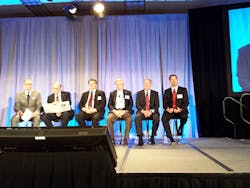HDMA Dialogue focuses on shifts in technology, regulation
The rise of information technology, data integration and tighter regulation and enforcement are among the game changers in trucking highlighted March 10 at the annual Heavy Duty Dialogue presented in Nashville by the Heavy Duty Manufacturers Assn. Some developments, such as the move toward electronic logging devices (ELDs), represent a convergence of several major trends, presenters said.
Vehicle electronics, cameras and navigation systems are among the game changers on the truck itself, but the biggest game changer of all today is what’s happening with the people driving those trucks, said Tom Kretsinger, president of Liberty, Mo.-based American Central Transport.
“We are seeing a capacity meltdown at our company the likes of which I have never seen,” said Kretsinger, who moderated a session on changing technology. The driver shortage recently led ACT to drop a shipper that it previously considered to be a great customer because of unfavorable scheduling from the perspective of drivers, he said. “If a customer is unfriendly to a driver it is coming under the microscope.”
The legal climate is another huge issue, Kretsinger said. “I have never seen it more challenging for a carrier to make a decision without incurring liability.”
Concern over liability and safety is driving adoption of in-cab cameras, said trucking executives participating in a panel discussion.
“I am a big believer in camera technology,” said Aaron Tennant, chief executive officer of Colona, Ill.-based Tennant Truck Lines. Tennant said he wants all the information he can get on a crash. If the truck driver is not at fault, that’s great, but even if he is, it’s important to know that immediately and proceed accordingly. “I believe it makes the driver stronger if he knows he is being monitored.”
The other carriers represented on the panel – Crete Carrier Corp., Southeastern Freight Lines and TCW – either used camera technology or were testing it.
In addition to litigation, the Compliance, Safety, Accountability program represents a major game-changer in the area of safety and compliance technology and practices, fleet executives said. That’s unfortunately, some said, because the program is flawed.
“I don’t believe CSA is fully ready yet,” Tennant said. “Our CSA scores may bounce up and down 20 or 30 points from month to month based solely on what our peer group is doing.
“The measure does not predict which carriers are safe and which aren’t,” said Dave Manning, president of TCW. “It needs to be taken out of the public view until it is right.”
One of the biggest CSA-related issues Southeastern faces are shippers’ bracketing and bracing inside trailers, “which we have no control over,” said Lee Long, director of fleet services.
Right or not, CSA is one of the major reasons carriers are adopting ELDs in advance of the upcoming mandate. The program affects costs and practices throughout the operation. Southeastern adopted an outbound check lane. Crete began using inbound inspection lanes, said Kirk Altrichter, vice president of maintenance. “It’s tires, lights and brakes – the three big CSA issues,” he said.
Driving efficiency and safety
Several Dialogue presenters focused on the reality and promises of information technology to fine-tune the safety and efficiency of trucking operations. For example, integrating engine and transmission electronics allows for precise gear shifting to save fuel and reduce driver fatigue, noted Rich Ferguson, senior vice president, aftermarket and soft products for the Volvo Group.
Technologies already on the truck also can be applied in new ways to squeeze out greater efficiency, Ferguson said. For example, the engine and transmission electronics can interact with the navigation system to optimize performance based on not just current terrain but terrain on the road ahead.
Given tight capacity, uptime and utilization are critical, and the ability of the truck to “talk” with other parties, including maintenance networks, can help not only diagnose problems but automatically arrange for service, Ferguson noted.
In safety, the big game-changer is automation, said Jon Morrison, president and general manager of Meritor WABCO Vehicle Control Systems. The integration of collision mitigation systems with braking and other vehicle control systems allows the truck to step in situations where the driver might not have even identified a problem.
While the industry might be close to exhausting the potential for integration within a vehicle, the next frontier will be interacting with other vehicles, Morrison said. Vehicle-to-vehicle (V2V) communications eventually could allow for driverless vehicles, but there are some challenges. Ensuring the security of communications is vital, but in the absence of a regulatory mandate, the issue of payback is huge because the early adopters won’t have many vehicles to interact with, Morrison says. So V2V is a bit of a leap of faith.
Given that trucking is a mobile industry, it’s understandable that carriers have adopted telematics to deal with increasingly complex regulations and to obtain returns on investment in fuel costs, productivity and customer service, said Brian McLaughlin, president of PeopleNet. What began as a simple desire for locating and messaging has led to widespread integration with other systems, he says, noting that 95% of PeopleNet installations are integrated with at least one other application.
McLaughlin identified 10 game changers in telematics in back-office and mobile enviroments:
- Analytics
- Scorecards/alerts
- Extreme integration
- Mobile applications
- Portability
- Safety systems
- Navigation
- Remote diagnostics
- Driver coaching
- ELDs/EOBRs
Other speakers at HDMA Dialogue addressed the legislative and economic environment for trucking and commercial vehicle suppliers.
